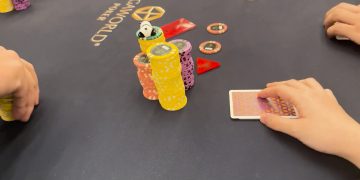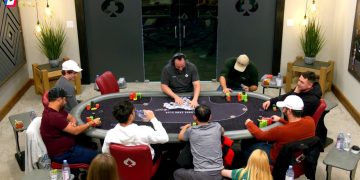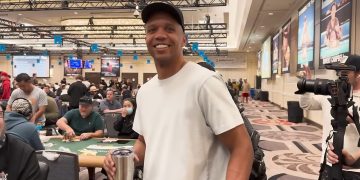The most common poker strategy for heads up poker is to be aggressive. That’s not necessarily a poker strategy, it’s more of a style of play, and it’s correct for heads up poker, but it shouldn’t be taken too literally. If you do that, you’re going to play recklessly. That’s against our poker rules for winning. We don’t want that.
First we’ll take a look at what you should and shouldn’t do when playing heads up poker. Then I’ll give you seven examples of heads up poker. I have been fortunate to go 6-1 when heads up, but two of these were heads up matches, not from poker tournaments. The other five were from poker tournaments. I will tell you how I played it, why I played it the way I did, and how it led to some wins.
Exploit Your Opponent

If you talk to most poker pros about playing heads up poker, they’re going to say, “You need to be uber-aggressive. Take control and don’t let go.”
Those might not be their exact words, but that will be the overall premise. I believe they are correct, but only to a certain degree.
Against a passive player, you want to open-raise pre-flop almost every hand. Don’t worry about your cards. You’re not playing your cards. You’re playing your opponent. If your opponent folds, great. You just picked up some chips. If a passive opponent calls, even better. They’re usually going to miss the flop, which gives you an opportunity to win more chips.
If you continuously apply pressure against a passive opponent when playing heads up poker, there is only one way they can win, which is for them to run extremely well. That will happen once in a while, but it usually won’t. Therefore, you must have the long-term mindset of relentless aggression against this type of player. This definitely falls within our poker rules for winning.
Never worry about betting out and your opponent having a stronger hand. If a player like this has a stronger hand, they’re usually going to raise. Make sure you fold most of the time in these spots. In some cases, they might smooth-call because they know you’re aggressive and want to string you along. What they don’t realize is that you know they usually fold. If they call, then you know there is a reason for it. Your radar should go up in these spots.
In short, a passive poker player isn’t using any real poker strategy. They are playing face-up because their betting patterns indicate the strength or weakness of their hands. Raise, raise, and raise until you are met with resistance. Then fold. This in itself will drive your opponent insane, and it will potentially put them on tilt.
If you’re playing heads up poker against a loose opponent, you should still be open-raising pre-flop most of the time, but reel it in a little bit. Don’t play absolute junk. You still want to raise with any pair or picture card. Suited-connectors and suited one-gappers aren’t as valuable in heads up poker because you’re not drawing for a big pot. You still want to play those hands, and you definitely want to mix up your betting patterns, but pairs and higher cards will have more value in heads up poker.
Against the loose player, you want to trap sometimes, but not all of the time. The best way to play your poker hands against this opponent is to mix up your play. This relates to changing up your betting patterns. On one hand, bet out when you flop top pair. The next time you flop top pair, check. On one hand, 3-bet pre-flop with 77. The next time you have a middle pair, flat.
This is the key to everything in heads up poker simply because the goal is for a player to pick up on their opponent’s betting patterns, which then leads to exploitation. By consciously altering your betting patterns, you’re not allowing your opponent to exploit you. You might lead them to believe they can exploit you based on the signals you’re sending, but they will be misinformed.
As I often like to point out in relation to Texas Hold’em poker tournaments, too many people focus solely on reading their opponent. This, of course, is something you need to do. However, too few people focus on entering the mind of their opponent to see how that opponent views them.
If you can send incorrect signals to your opponent, it’s almost like you have crawled inside their mind and led them down an incorrect path without them having any idea. Think of it as infiltrating someone’s brain. This is how you win in Texas Hold’em poker tournaments and poker games in general.
Before moving on to my personal experiences with heads up poker, I would like to point out one more thing with poker hands in heads up poker. Never underestimate your opponent, but don’t overestimate them either, especially when it comes to fatigue and impatience. Your opponent will eventually grow tired. The more tired they get, the more opportunity you have to seal the deal.
Therefore, if you have anything better than top pair at any point, don’t be afraid to jam it. Your opponent will usually fold, and once in a while they will have you beat, but if you use this approach consistently, you’re going to win a lot more than you lose. It’s such a great feeling when they tiredly say, “Call.” It’s sometimes surprising, but they’re often thinking that 2nd place is good enough. We’re never thinking that.
Heads Up Poker Match #1: The Baseball Guy
This was a private heads up poker match for a decent amount of money. My opponent was a college baseball player and knew me through a friend. Once he heard more about me, he challenged me to a heads up poker match. I accepted.
This was earlier in my poker career, so I wasn’t as strong of a player, but I was determined to win. He wasn’t passive, but he was a tight player. This made it a little tricky because he could be sticky (I didn’t intend a rhyme there). My approach was simple: Grind him down and out-wait him.
Due to being inexperienced at the time, I didn’t raise nearly as much as I should have. I was basically playing my cards, but I had a gut feeling that the most patient player would win this match. We were both extremely patient, which is why it took so long. Eventually, my opponent got frustrated and made a loose call for a big pot. Once that happened, I knew it was game over. This is when I started to apply pressure. He went on tilt and started calling light. It was a methodical win.
He seemed like a cool dude, so I felt a tinge bad when he screamed an obscenity from the next room while collecting my winnings. Then again, he challenged me, so hey.
Heads Up Match #2: Granny
I began playing poker against my grandfather when I was five years old. I continued playing against him until I was 19 years old, when he passed away. During those 14 years of play, I never beat him. This was good because it made me stronger, and it taught me a lot about heads up play. We weren’t playing Texas Hold’em poker tournaments, but we were playing all different kinds of poker games as well as other card games. If I played him today, I believe I would win, but I’ll never know.
You might be thinking I played against my grandmother for money, but no, she was too nice for that. Once again, a friend told me I had a challenger, and it was her granny. This wasn’t your average granny. From what I had learned from multiple sources, this woman used to clean house in poker games in the back of bars and pool halls. I knew it would be a challenge.
I was right. She was tough. I remained focused and waited for my spot. After two hours of going back and forth, I thought this would be my spot…
I held
![]()
![]()
on this board:
![]()
![]()
![]()
![]()
![]()
Granny had called my pre-flop raise. She then called my bet on the flop and turn. She jammed it on the river. What could be going on here?
She called most hands pre-flop, so it was tough to put her on a range. I first had to look at the betting patterns, which was simply her calling me all the way to the river and then jamming. She was sticky on most hands, so she could have anything. I was almost certain I had her beat on the flop, so I didn’t have her on a stronger ace, two pair on the flop, or a set.
She could have been drawing to spades and then felt there was too much in the pot to let it go, firing a massive bluff. I didn’t think it was possible she had a straight because she wouldn’t have called the flop with a backdoor straight draw. She might have been sticky, but she wasn’t stupid. The other possibility was a pair on the flop that turned into two pair by the river, which concerned me the most. If I lost to Granny, I would never hear the end of it.
Since I couldn’t figure it out via betting patterns, I casually glanced at Granny. I didn’t want her to know I was evaluating her. She was very still. Her shoulders were high and tight and her facial muscles weren’t budging. She basically looked like a statue. She didn’t want to give anything away.
This might have worked in the backrooms of bars and pool halls, but I had now played against enough people on relatively big stages to know that her posture and facial expression were unnatural. I put her on a bluff and called
She tabled
![]()
![]()
She missed her flush draw and it was a bluff. I had her covered. Game over.
Despite this being a win, this was the toughest heads up poker match I’ve had to date. For a heads up poker match to go more than two hours is complete insanity.
Heads Up Match #3: Harrah’s Cherokee Poker Classic Turbo Event

This tournament will always stand out to me because I told myself I was going to win it while driving to Harrah’s Cherokee. It wasn’t a pump-up thing or anything like that, it was a decision.
When it was down to seven players, I thought I was out. I even got up to leave, but a Russian player informed the dealer that I had a straight against another player. The dealer and myself had both missed it. I sat back down and ended up playing heads up poker vs. the Russian. Spoiler Alert: No good deed shall go unpunished.
He was tough because he was aggressive while still mixing up his play. I knew I needed to do something to get the advantage. Check-raised-bluffed and he folded on the turn on one big pot. I knew it was game over.
A few hands later, I picked up AA, which was very fortunate because he jammed it with QT on this flop: Q87. A little bit of a sweat, but my hand held.
I won a $3k Movado watch. Three people offered to buy the watch from me for $3k right on the spot. I declined. That watch is now worth a couple hundred dollars because Movado makes too many watches for them to have any real value. Personal Tip: If you ever win a $3k Movado watch at a poker tournament and someone offers you $3k for it, take the money.
Heads Up Match #4: Coconut Creek
This was a winner-take-all tournament for an all-expenses-paid trip to St. Maarten. It also included a Main Event seat for a WSOP International series.
I’ll give you the short version on this one. Once getting the chip lead, I began flatting and folding marginal hands to make myself appear weak, knowing it would lead to him jamming often. My plan was to continue folding to his jams as long as I maintained the chip lead, and calling if I happened to be dealt a strong hand so I could end it. I was dealt AQ, checked it, and he jammed. I snap-called. He had KT and my hand held. I was off to St. Maarten.
Heads Up Match #5: Tunica I
This was in a Nightly at the WSOP Circuit in Tunica. My opponent was a maniac, and every time I tried to extract chips from him, he folded. I wasn’t running good, but I folded more often than I should have.
I always prefer to go out swinging, and I didn’t do that on this day. Played too tight, which led to the blinds eating me up. Looking back on it, I don’t know what I was thinking. I guess I was just off my game. I didn’t think that was the case at the time because the only reason I got to the heads up poker match is by calling with ace-high vs. some young kid for 225,000 chips. Everything seemed on. But this was a loss.
What’s funny is that a few months later, I saw that same guy who beat me and he came up to me asking for poker strategy advice. I guess I didn’t play too bad that night after all. Who knows?
Heads Up Match #6 Tunica II
This was during my second WSOP Circuit Tunica trip. It was the same trip where the player above asked me for advice, but that’s not who I was up against this time. I was up against a guy who said the same thing every single flop: “Oh Wow! Look at that!”
This was ridiculous. I don’t know what his angle was, but he wasting his breath. If someone does the same thing every single time, it’s meaningless. He won some big pots off me, several times swinging the advantage in his favor, but I kept getting the chip lead back by applying pressure pre-flop. Stealing the blinds and antes is what kept me in this thing.
It was a tug-of-war, with him winning bigger post-flop pots and me always crawling my way back by stealing blinds and antes. I eventually made a hand with a slight chip lead. I had turned two pair. Then I jammed and he called. He had a smaller two pair and I was happy to take it down.
Heads Up Match #7: Cherokee
This wasn’t a Circuit event. This took place during a regular Cherokee poker tournament. Once at the final table, I knew I was winning this tournament. The players were soft. A couple of them were aggressive, but their aggression was always in the form of all-in, so I just folded to those bets.
When it got down to heads-up, I knew my opponent saw me as a maniac. This wasn’t my real identity. I was playing that way because the table was soft. Since he saw me as a maniac, I knew it was very possible to get a call with all-in bets. On the second hand of playing heads up, I was dealt KK. I didn’t waste any time and jammed it pre-flop. He called with AT. My hand held. This was the shortest heads up poker match of my career. And I would like to say to all poker players: The ace doesn’t always come.
I have had many other wins in Texas Hold’em poker tournaments, but most of them have been chops. There is no heads up poker in those situations.
Final Thoughts
You want to be aggressive when playing heads up poker, but a lot depends on your opponent. Figure out your opponent’s tendencies and exploit them accordingly. If you want to significantly increase your chances of winning, then I would highly recommend altering your betting patterns so they have incorrect information on how to exploit you. See you at the Final Table!
♠ pokerjournal.org
Heads Up Poker – FAQ
Who is first to act in heads up poker?
The button is first to act pre-flop because the button is the small blind, but the button is last to act on all post-flop streets.
How do blinds work in heads up poker?
The button is the small blind and the other player is the big blind.
What is a good strategy for heads up poker?
Attack! Attack! Attack! You might get caught once in a while if your opponent is lucky to catch a hand, but in most cases, you're going to win by being the more aggressive player.
Why should you consider a chop in heads up poker?
You should only consider a chop if you're at a disadvantage due to chips and/or skill. You can also consider a chop if the stacks are about even and you believe your opponent is equally skilled or a stronger player. I will never ask for a chop, but I will always consider it if offered.


















Discussion about this post